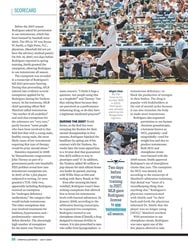
RODNEY ROGERS
HE HIT the ditch and careened toward the ground, but for Rodney Rogers, falls were a part of dirt biking. Growing up in Durham, N.C., Rogers had had dozens of tumbles, some on this same trail in Vance County, near his house. He'd always dusted off his 6'7", 270-pound frame and hopped back on his motorized ride. Not this time. On a cool afternoon in November 2008, Rogers couldn't get his arms up in time to break his fall. Landing on his head, he broke his third cervical vertebra and bruised his spinal cord at the fourth. And just like that, the burly 12-year NBA veteran, three years into retirement, was paralyzed below the shoulders.
Rogers was held in intensive care at Atlanta's Shephard Center for three months following the accident, and he had to be resuscitated three times. For most of his hospitalization, doctors placed his chances of survival at around 50-50. "People ask me what the toughest part was," Rogers, now 43, says. "The toughest part was staying alive."
At home the former forward for seven NBA teams struggled to adjust to life as a quadriplegic. He fell into a deep depression, shutting himself in his bedroom for weeks at a time. One year after the accident he told Faye Suggs, who was then his fiancée, that he wanted to commit suicide. O.K., Faye told him. "But I can't live without you," she added, "so if you do it, I'm doing it too." Rogers balked. "I didn't care what condition he was in," says Faye. "I just wanted my Rodney. I needed him to live."
Slowly Rogers pieced his life back together. In 2010 he wed Faye in a quiet backyard ceremony in Timberlake, N.C. That same year he started the Rodney Rogers Foundation to help others with paralysis. Now, after years of his refusing to leave the house, says Faye, it's hard to keep him in it. The two regularly go out to dinner and movies. Rogers travels to basketball camps across the country and speaks at the NBA's rookie transition program.
Every day is still a challenge for Rogers. He requires the aid of a ventilator to breathe. Because of his size he needs around-the-clock care from nurses. In 2010 he was diagnosed with diabetes. His medical expenses hover around $400,000 per year, which are paid for with insurance. The complications of Rogers's paralysis have made him and his wife appreciate their time together. "We know that anything can happen at any time," says Faye. "It's why we live every day to the fullest."
PHOTO
TRAVIS DOVE FOR SPORTS ILLUSTRATED
SUPPORT SYSTEM Rogers got so depressed he considered suicide, but Faye refused to let him give up hope.

